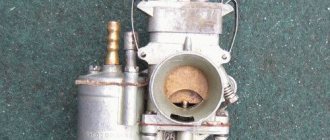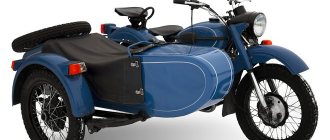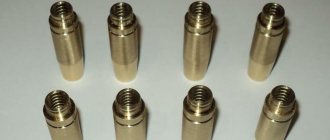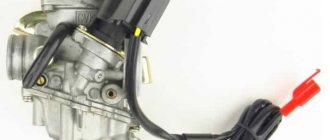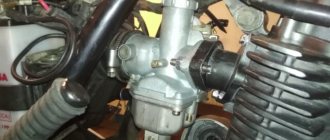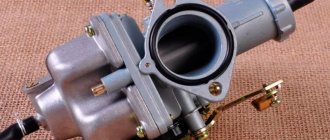In the conditions of mass production of internal combustion engines, it is impossible to ensure perfect manufacturing accuracy; as a result, engines coming off the same assembly line may differ from each other within certain limits. The same situation occurs with the production of engine fuel system elements, in our case, carburetors.
The matter is further complicated by the fact that initially the engine manufacturer does not know in what climatic conditions a specific engine model will be operated. As you know, the same engine will operate completely differently in different climatic conditions.
Designers designing engines are well aware of these problems and therefore introduce adjusting elements into the power system (in our case, the carburetor), by influencing which you can significantly improve the efficiency, power and dynamic performance of your scooter’s engine based on specific operating conditions.
First, a little theory.
As you know, a carburetor is a device in which the working mixture (a mixture of air and gasoline) is prepared, without which the operation of the internal combustion engine is impossible. The most optimal ratio of gasoline and air in the working mixture is the value: 1/15, that is, for 15 kilograms of air there is 1 kilogram of gasoline. With such a mixture, the engine will operate without interruptions and detonation. This mixture is usually called optimal.
Unfortunately, at the optimal mixture, the scooter engine in some modes will not be able to operate stably, for example: in cold start mode, for stable operation the engine requires a mixture in which there is slightly less air than in the optimal mixture, the ratio of such a mixture is: 1/13, that is For every 13 kilograms of air there is 1 kilogram of gasoline. This mixture is usually called “rich”.
In order to enrich the mixture at the right time, additional modules (starting enrichers) are introduced into the carburetors, which are essentially mini carburetors; more details about the operation of the starting enricher are written in the article: Automatic starting enricher for a scooter
The most dangerous for engine operation is considered to be a lean mixture (a combination of gasoline and air of approximately 1/17 or lower. When the engine operates on such a mixture, detonation occurs and overall engine overheating, which ultimately leads to burnout of the piston or cylinder head gasket, melting of the internal surface of the cylinder head, such “little things” as burnout of the exhaust valve need not be mentioned at all.
We place the scooter on the central stand, provide free access to the carburetor adjustment elements, and warm up the engine (a prerequisite for high-quality carburetor adjustment).
We begin the process of setting up the carburetor by adjusting the idle speed. For this purpose, there is a special bolt on any carburetor (marked with an arrow), by rotating which you can increase or decrease the idle speed. By rotating the idle speed bolt, we achieve minimum, but at the same time stable engine speed.
After adjusting the idle speed, we proceed to adjusting the quality of the mixture. For this purpose, the carburetor has a mixture quality bolt (marked with an arrow), by rotating which you can change the composition of the mixture within certain limits. On different models of carburetors, the “quality” screw works on a different principle: in one case, the “quality” screw closes the air channel of the idle system, thereby reducing or increasing the amount of air in the mixture (enriches or leans it), in another case, the “quality” screw regulates the amount of ready-made mixture (emulsion) entering through a special channel into the engine intake manifold.
In general, there is no particular difference between the two principles of operation of a “quality” bolt, except that in the first case, when tightening the screw, the mixture becomes richer, and in the second, when tightening the “quality” screw, the mixture becomes leaner, keep this point in mind.
We determine the correctness of adjusting the quality of the mixture as follows: after adjusting the quality bolt, we give sharply full “gas” (preferably while driving), the engine should confidently develop speed without jerking delays and detonation, a pronounced “catch” should be felt. If the engine unsteadily picks up speed, detonates or stalls when the throttle is suddenly closed, then you should once again adjust the position of the quality screw until the engine begins to develop speed with a pronounced “catch”.
If, after adjusting the quality screw, it is still not possible to achieve normal operation from the engine, then we try to lower or raise the carburetor needle in increments. If the engine picks up speed poorly (rich mixture), lower the needle; if the engine picks up speed unsteadily, detonates and stalls when the throttle is closed abruptly, raise the needle. Try to raise and lower the needle one division at a time and not immediately all the way up or down.
You can read more about the structure and adjustment of the needle in the article: Photo report: Design of the carburetor of a four-stroke scooter (carburetor 4t) or in the article: Photo report: Disassembly and design of the carburetor of a two-stroke scooter (carburetor 2t).
Next, after all that has been done, we drive the scooter for several kilometers as usual, unscrew the spark plug and visually determine by the color of the spark plug insulator what mixture the carburetor is “preparing.”
If the spark plug insulator is black and covered with a layer of soot, then the carburetor is “preparing” a “rich” mixture, in this case the situation can be corrected by lowering the carburetor needle to the desired division.
If the spark plug insulator is snow-white, it means the carburetor is “preparing” a “lean” mixture, in this case the situation can be corrected by raising the carburetor needle to the required division.
If the spark plug insulator is sand or brick-colored, then your carburetor is preparing the optimal mixture and no further adjustment is necessary.
After the final adjustment of the carburetor, you should adjust the free play of the throttle cable; for this purpose, there is a special nut on the cable by tightening or tightening which you can reduce or increase the free play of the cable. The free play of the throttle cable should be: 1-2 mm.
On some models of scooters equipped with 2T engines, after final adjustment of the carburetor, the positions of the oil supply control drive should be adjusted. To do this, just like in the first case, we look for the adjusting nut on the oil supply system drive cable and tighten and release the nut until the marks (marked by arrows) are opposite each other.
Adjusting the carburetor of the Stealth scooter
Scooter owners sooner or later encounter poor performance of their “iron horse”. The reasons can be completely different, one of which is a problem with the scooter’s carburetor. In this case, it is necessary to disassemble the carburetor, clean it and readjust it. Further in the article we will tell you how you can adjust the carburetor of the Stealth Tactic 50 scooter. Looking ahead, it is necessary to say the following: adjusting the carburetor with your own hands is more than possible. To do this, you need to be familiar with the structure of the carburetor and the principle of its operation. If difficulties arise during the disassembly process, you can always turn to specialists for help who will do everything in the best possible way.
This is interesting: How to remove the starter on a Ford Focus 2
So, let's begin. The needle located in the air damper should not move over a wide range. It is best to move such a needle with a corkscrew ring, which must be placed in the grooves. We insert the ring into the middle groove, then fully tighten the bolt responsible for the quality of the mixture and unscrew it a quarter turn. Next, we start the engine. We listen carefully to the operation of the engine. If the idle speed is not stable and is higher or lower than optimal, it is necessary to adjust the screw responsible for idle speed.
After this, you need to bring the idle speed to maximum using the screw responsible for the quality of the mixture. Done? – loosen by ½ turn. If everything is done according to the instructions, everything should be fine. We check the work done: we set off and pick up speed. If there are no failures in engine operation, then everything was done correctly. But, if there are so-called “dips,” it is necessary to tighten the screw another ¼ turn. Be sure to adjust the idle speed screw after fine-tuning the quality screw.
Adjusting the Stealth carburetor is practically no different from adjusting any other Chinese element of the fuel system of a 2-stroke scooter. You may not be able to do everything perfectly on the first try, but repetition is the mother of learning.
Chinese carburetor for 125-150cc engine - disadvantages and tuning.
What is the carburetor of a Chinese scooter and its capabilities, disadvantages, tuning.
The carburetor in a Chinese scooter with an engine capacity of 125-150 cm3 is installed from a line of constant vacuum carburetors.
This type of carburetor is also installed in Chinese-made motorcycles, ATVs, and snowmobiles, but what makes it so popular? The answer is simple - smooth running, safety, efficiency, environmental friendliness. Even in a simplified and cheaper version, which is used in China, it is applicable for use in Europe under strict environmental and safety requirements. The lack of reliable information among users of Chinese-made motorcycle products has given rise to many myths and misconceptions - this is noticeable when contacting us for advice when tuning an engine and specifically a carburetor. 1.What does a typical, standard Chinese carburetor look like for a 4-stroke engine with a volume of 125 cubic centimeters or more. One of the options, because they may differ slightly.
This carburetor does not have a manufacturer's mark, model, or serial number - a complete unknown. Most often, such carburetors need to be carefully measured, because they leave a lot of room for hoaxes.
This version has some symbols that bring us closer to the clue to the origin of this carburetor.
There is a modified logo of the prototype from which this carburetor was copied - the Keihin brand. Above you can see the imprint of the Chinese manufacturer - the letters K F. Please do not be mistaken - this is not a type of carburetor, there will be information about it a little later. Then there is the imprint STANDARD OF JAPAN, which means absolutely nothing. This carburetor was not made in Japan, that's for sure. Whether it was made to the high standards of Japan is also highly doubtful. This inscription is designed only to make the user think that his carburetor is somehow Japanese - which is not true. The serial number is stamped on the carburetor, which is a positive factor - the manufacturer monitors the quality of the product to some extent, there is a link to at least something. But this is not a guarantee that the product is of high quality, but only one of the factors.
There is also such a “miracle” - an outright fake with an unsuccessful attempt to imitate the Keihin logo and inscription, but such products are generally beyond criticism for many reasons.
DESIGN OF JAPAN, TECHNOLOGY FROM JAPAN - there is no such inscription on any Japanese carburetor, remember this. The inscription “Japan, Made in Japan” may be cast on the carburetor, but not on a Chinese carburetor.
What is the name of this carburetor, this photograph alone gives an idea.
Carburetor model PD24J. The VE carburetor type is also visible, which is a residual from the original. Just don’t rush to open a search in the hope of finding a Keihin PD24J - such a model does not exist! PD24 is absolutely the “Chinese name” of the original Keihin VE24 carburetor, little information about which can be found on the Internet. Why is there little information about the original? It is outdated and of little use compared to the more modern Keihin CVK series.
How to adjust the carburetor on a scooter?
The carburetor is an important part of the scooter engine power supply system, and the ride quality and engine efficiency depend on its proper operation. Sometimes the carburetor needs adjustment. In this article we will tell you how to properly adjust the carburetor of a scooter.
So, in what cases is it necessary to adjust the carburetor on a scooter? There are three reasons:
- Have you noticed a drop in engine power?
- Scooter won't start
- The engine stalls
The problems described above are mainly related to the quality of the fuel mixture. This may, for example, be evidenced by the white color of the spark plug, which indicates that the fuel mixture is oversaturated with air. The black color of the candle is a sign that the carburetor is pouring more fuel than necessary.
Therefore, for stable and efficient operation of the engine, the correct ratio of air and fuel in the fuel mixture is necessary, for which the carburetor is responsible. Before adjusting the carburetor, it is recommended to clean the carburetor itself and the air filter. It is also advisable to adjust the fuel level in the carburetor float chamber.
As a rule, adjusting the carburetor of a scooter consists of recreating the factory settings of the carburetor, when the fuel mixture quality screw is unscrewed by one and a half to two turns, and the cold speed screw by two and a half turns. To set these settings, you need to tighten the screws clockwise and then unscrew them again, but this time by the required number of turns. Resetting to factory settings usually solves many problems associated with carburetor malfunction. If the engine does not stall and runs steadily, and its power is sufficient for confident acceleration to maximum speed, then no further carburetor adjustment is required. However, if one or more malfunctions still remain, then it is worth continuing the setup until all problems are completely eliminated.
To do this, unscrew the fuel mixture quality screw two turns. Then you need to slowly start twisting clockwise. At the same time, the engine speed will begin to increase. The clutch will then be engaged, causing the rear wheel to rotate. After this, you need to smoothly turn the idle speed screw in the opposite direction.
After this procedure, you need to check the operation of the scooter. To do this, you need to accelerate it on a flat road. If the acceleration is slow, then there is not enough gasoline in the fuel mixture. To fix this, you need to turn the fuel mixture adjustment screw clockwise a quarter or half a turn.
However, there may be another option when the scooter accelerates confidently, but cannot reach maximum speed. This indicates that there is too much gasoline in the fuel mixture. To fix the problem, just unscrew the fuel mixture adjustment screw a quarter or half a turn. The carburetor adjustment is based on a simple principle: if you turn the fuel mixture adjustment screw clockwise, the mixture becomes richer; if you turn it counterclockwise, the fuel mixture becomes leaner.
Scooter: adjust the carburetor with your own hands
One of the main components in the fuel mixture supply mechanism in a vehicle such as a scooter is the carburetor. Before moving directly to the description of the adjustment process, let's talk about why it is needed at all.
Carburetor - a device that ensures the formation and supply of a fuel mixture (consisting of air, gasoline and oil) directly to the engine
What exactly is the purpose of a carburetor? In a nutshell, this is a device that ensures the formation and supply of a fuel mixture (consisting of air, gasoline and oil) directly to the engine. That is, the quality of this mixture and, accordingly, the power that the power unit produces depends on it.
Scooters typically use carburetors of a type called “float” carburetors. The main element is a Venturi tube, which houses a damper that regulates the amount of air supplied to the mixture, as well as a needle that supplies gasoline. By unscrewing the throttle, we thereby open the throttle and raise the needle, increasing the amount of air-fuel mixture entering the engine.
Naturally, the movements of the valve and the needle must be clearly synchronized to ensure its (mixture) homogeneity. The float chamber is designed to ensure the constant presence of gasoline in the tube. The principle of its operation is based on the fact that when the fuel level drops, the float lowers and opens a channel for supplying gasoline to the tube. When it is full, the float rises and closes the valve, thereby stopping the flow of fuel.
If the scooter's engine power drops, it is impossible to start the engine or the engine stalls - these are signs of a carburetor failure
Signs that the carburetor is faulty may include:
- Engine power drop
- Inability to start the engine
- The engine stalls.
Another way to assess the quality of the carburetor (more precisely, the correctness of its operation) is as follows - unscrew the spark plug and look at its color. If it is white, it means the fuel mixture is lean, that is, there is too much air in it, and if the spark plugs have a black tint, it means the carburetor is “pouring” too much fuel. With any of these options, one thing is clear - it needs adjustment.
It should be noted that, globally, this process does not depend on the engine stroke, therefore the answer to the question of how to correctly adjust the carburetor on a Chinese 4t scooter and how to correctly adjust the carburetor on a 2t scooter will be the same. Let's now move on to describing the sequence of actions.
This is interesting: On the road, the traffic police inspector took a photo of my driver’s license. Does he have the right to do this and why did he do it?
How to adjust the carburetor on a scooter
This procedure can be conditionally divided into two parts - adjusting the idle speed and adjusting the quality of the carburetor mixture. However, first, the carburetor must be removed and cleaned.
Refer to your vehicle's manual to ensure proper disassembly. Thoroughly clean all its channels, as well as the jets. Unscrew the spark plug - even if it does not have the visual defects described above, it is better to replace it. Fortunately, their price is usually not high. On the fuel metering needle, find the locking ring and install it in the middle groove. After all these steps, install the carburetor back.
After checking and cleaning, which we have just completed, we proceed directly to the adjustment. You will need to find elements such as the screw that regulates the quality of the fuel mixture (hereinafter referred to as the KTS screw), as well as the idle screw. Screw the KTS screw all the way (this is done clockwise), and then unscrew it one and a half turns, and then start the engine.
Using your scooter's tachometer reading, adjust the idle speed screw so that the engine speed is at 1800 rpm. Go back to the KTS screw and, by rotating it, achieve maximum engine speed, then tighten the screw half a turn. Find the idle screw again and return the speed to 1800 rpm, while not forgetting to check the operation of the engine by ear - there should be no failures or extraneous sounds.
When the specified value is set, you need to check the operation of the power unit. Turn the lever that controls the throttle a couple of times, adding gas and releasing it.
If you don’t hear any extraneous noise in the sound of the engine and it doesn’t stall, the carburetor adjustment has been made correctly, that is, you can safely get on the scooter and go about your business.
If the problem is not resolved, then it is necessary to look for the cause in other components of the vehicle.
It is worth noting that sometimes adjustment is not enough - it is also necessary to check and, in some cases, adjust the fuel level in the float chamber.
Locate and unscrew the butter screw, which is located at the very bottom of the device. Next, you should lift the tube and check the fuel level. It is necessary to carry out these actions with the engine running, and keep the upper edge of the tube slightly above the carburetor itself. The fuel level should be slightly lower than the junction of the lower and upper parts of the carburetor.
Video tutorial on adjusting the carburetor on a scooter:
If the level is lower than required, you will need to remove the cover and adjust the timing of the valve by carefully bending its holder (this should be done in very small ranges). You can perform this entire procedure at the very beginning, so if you don’t want to remove the part once again, start the process of servicing the fuel system by adjusting the fuel level in the scooter’s carburetor.
Full load mode
15 best motorcycles
The mechanically actuated economizer valve 33 is closed by a spring 34, which presses the ball valve 31 against the seat 30.
The valve opens when the throttle valve is in a position close to its full opening, due to the kinematic connection of the valve with the lever 37, rod 32, rod 21 and bar 20.
In this case, the bar 20, attached to the rod 21, comes into contact with the intermediate pusher 28 through the pusher 17 and moves it down.
The intermediate pusher presses on valve 31, and it moves away from the seat. Fuel passes through hole 27 and enters the main fuel channel 35.
The fuel dosage is carried out by the economizer valve jet, and then goes to the full power jet, the flow area of which is designed to prepare a mixture that provides full engine power.
